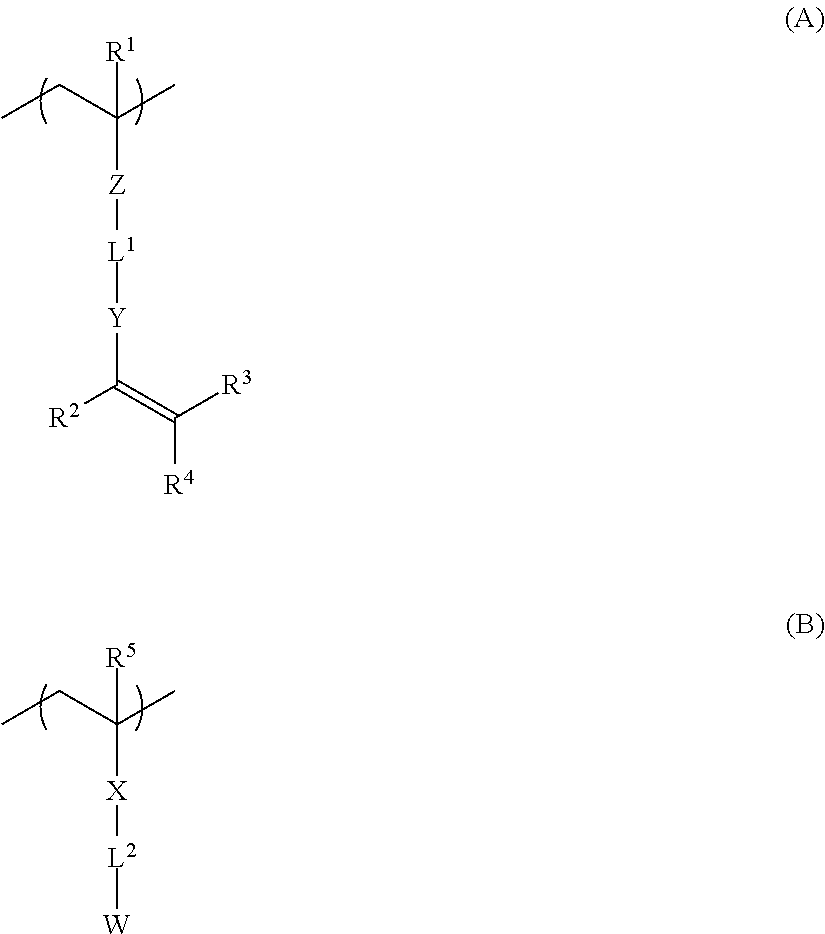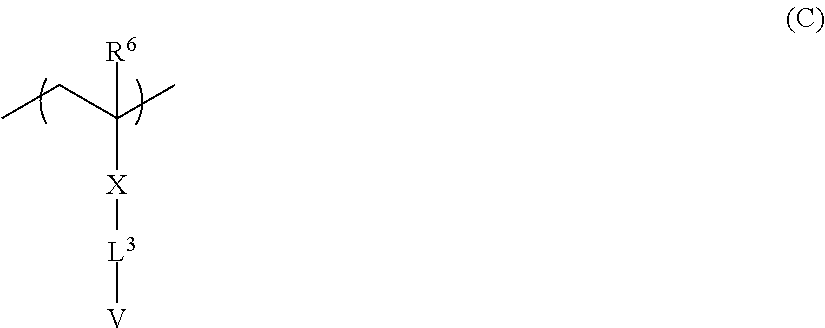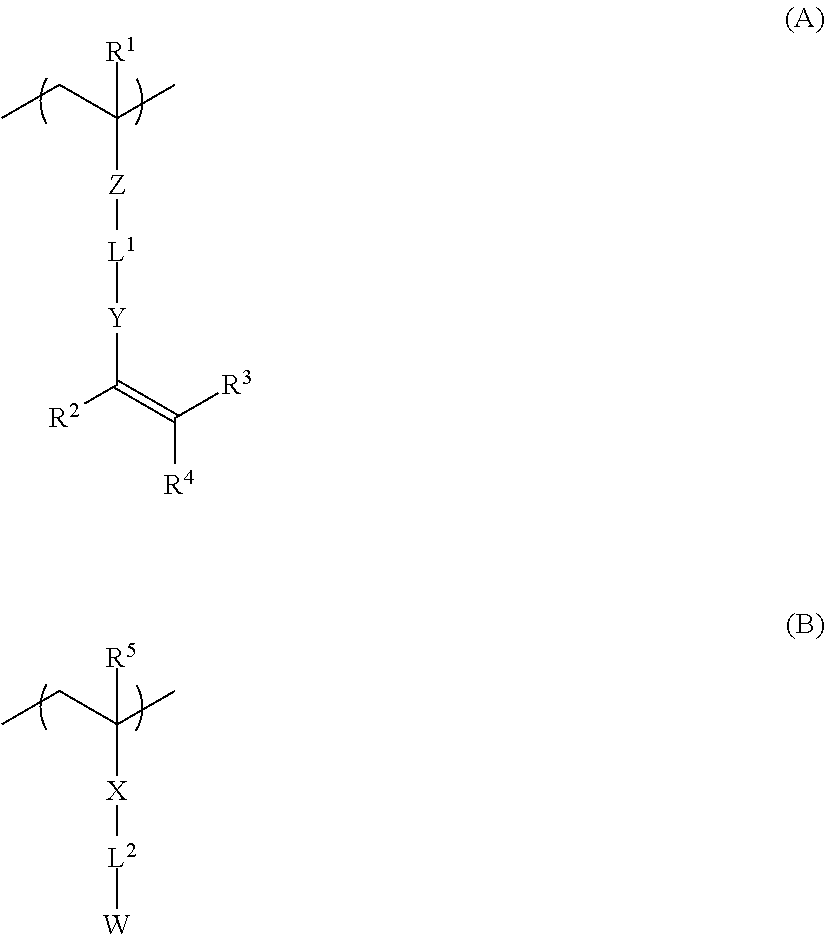Composition for forming layer to be plated, method of producing metal pattern material, and metal pattern material
a technology of metal pattern material and forming layer, which is applied in the direction of printing, electrography/magnetography, and the coating process of metallic materials, etc., can solve the problems of complex process, long development process time, and possible deformation of high-frequency characteristics
- Summary
- Abstract
- Description
- Claims
- Application Information
AI Technical Summary
Benefits of technology
Problems solved by technology
Method used
Image
Examples
example 1
[0382]Production of Substrate
[0383]A mixed solution, in which 12.3 mass parts of JER806 (bisphenol F-type epoxy resin: trade name, manufactured by Japan Epoxy Resins Co., Ltd.), 4.3 mass parts of LA7052 (PHENOLITE, trade name, manufactured by DIC Corporation, hardener), 20.9 mass parts of YP50-35EK (trade name, manufactured by Tohto Kasei Co., Ltd., phenoxy resin), 62.5 mass parts of cyclohexanone and 0.1 mass parts of 2-ethyl-4-methylimidazole (hardening accelerator) were mixed, was filtrated with a filter cloth (mesh #200). The thus-prepared coating liquid was coated on a glass epoxy substrate so as to be an adhesion-aiding layer according to a spin coat method (condition: dry film thickness of 6 μm), and then dried thereby obtaining substrate A1.
synthesis example 1
Synthesis of Specific Polymer A
[0384]20 g of N,N-dimethylacetoamide were placed in a 500 ml three-neck flask, and were heated to 65° C. under a nitrogen stream. Then, 20.7 g of monomer M (following structure), 20.5 g of 2-cyanoethyl acrylate (manufactured by TOKYO CHEMICAL INDUSTRY CO., LTD.), 14.4 g of acryclic acid (manufactured by TOKYO CHEMICAL INDUSTRY CO., LTD), and 20 g of a N,N-dimethylaceamide solution containing 1.0 g of V-65 (trade name, manufactured by WAKO PURE CHEMICAL INDUSTRIES, LTD.) were dropped in the flask over 4 hours. After the dropping, the content of the flask was stirred for 3 hours. Thereafter, 91 g of N-N-dimethylacetoamide were added to the flask and the reaction solution was cooled to room temperature.
[0385]To the above reaction solution, 0.17 g of 4-hydroxy TEMPO (manufactured by TOKYO CHEMICAL INDUSTRY CO., LTD.) and 75.9 g of triethylamine were added and allowed to react at room temperature for 4 hours. Thereafter, 112 g of a 70% aqueous solution of m...
example 2
[0404]Preparation of Composition B for Forming a Layer to be Plated
[0405]0.30 g (7.5% by mass) of the specific polymer A (solid content: 87% by mass) obtained by the synthesis method described above, 0.07 g (1.75% by mass) of sodium hydrogen carbonate, 1.63 g (40.6% by mass) of water and 2.0 g (49.9% by mass) of ethanol were mixed while stirring to dissolve the specific polymer A, and then 0.01 g (0.25% by mass) of water-insoluble photopolymerization initiator (IRGACURE 907, trade name, manufactured by CIBA JAPAN K.K.) were added thereto and stirred to prepare a composition B for forming a layer to be plated. At this time, the content of ethanol contained in the water-alcohol mixed solvent was 55.1% by mass. Further, after the production of the composition B for forming a layer to be plated and subsequent leaving to stand for 10 minutes, occurrence of precipitation was not found by visual observation.
[0406]A metal pattern material having a copper plating film was obtained in the sam...
PUM
| Property | Measurement | Unit |
|---|---|---|
| Percent by mass | aaaaa | aaaaa |
| Percent by mass | aaaaa | aaaaa |
| Percent by mass | aaaaa | aaaaa |
Abstract
Description
Claims
Application Information
 Login to View More
Login to View More - R&D
- Intellectual Property
- Life Sciences
- Materials
- Tech Scout
- Unparalleled Data Quality
- Higher Quality Content
- 60% Fewer Hallucinations
Browse by: Latest US Patents, China's latest patents, Technical Efficacy Thesaurus, Application Domain, Technology Topic, Popular Technical Reports.
© 2025 PatSnap. All rights reserved.Legal|Privacy policy|Modern Slavery Act Transparency Statement|Sitemap|About US| Contact US: help@patsnap.com



